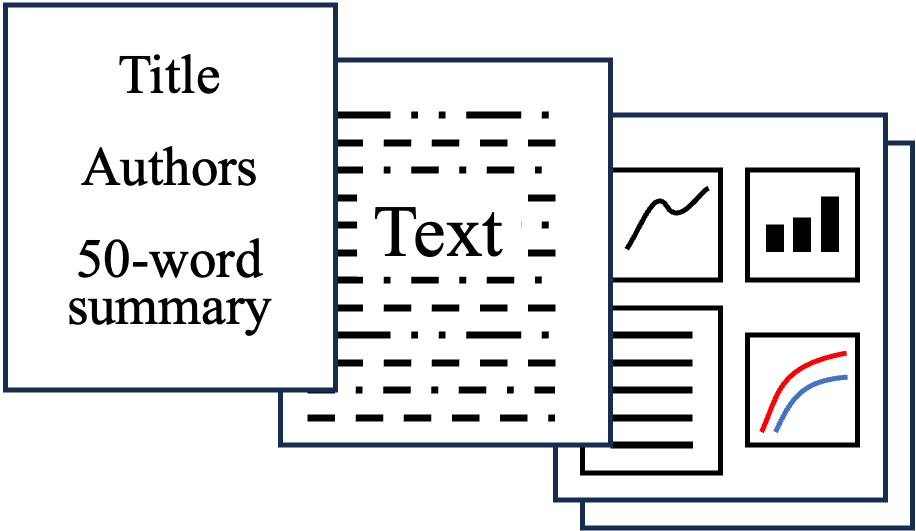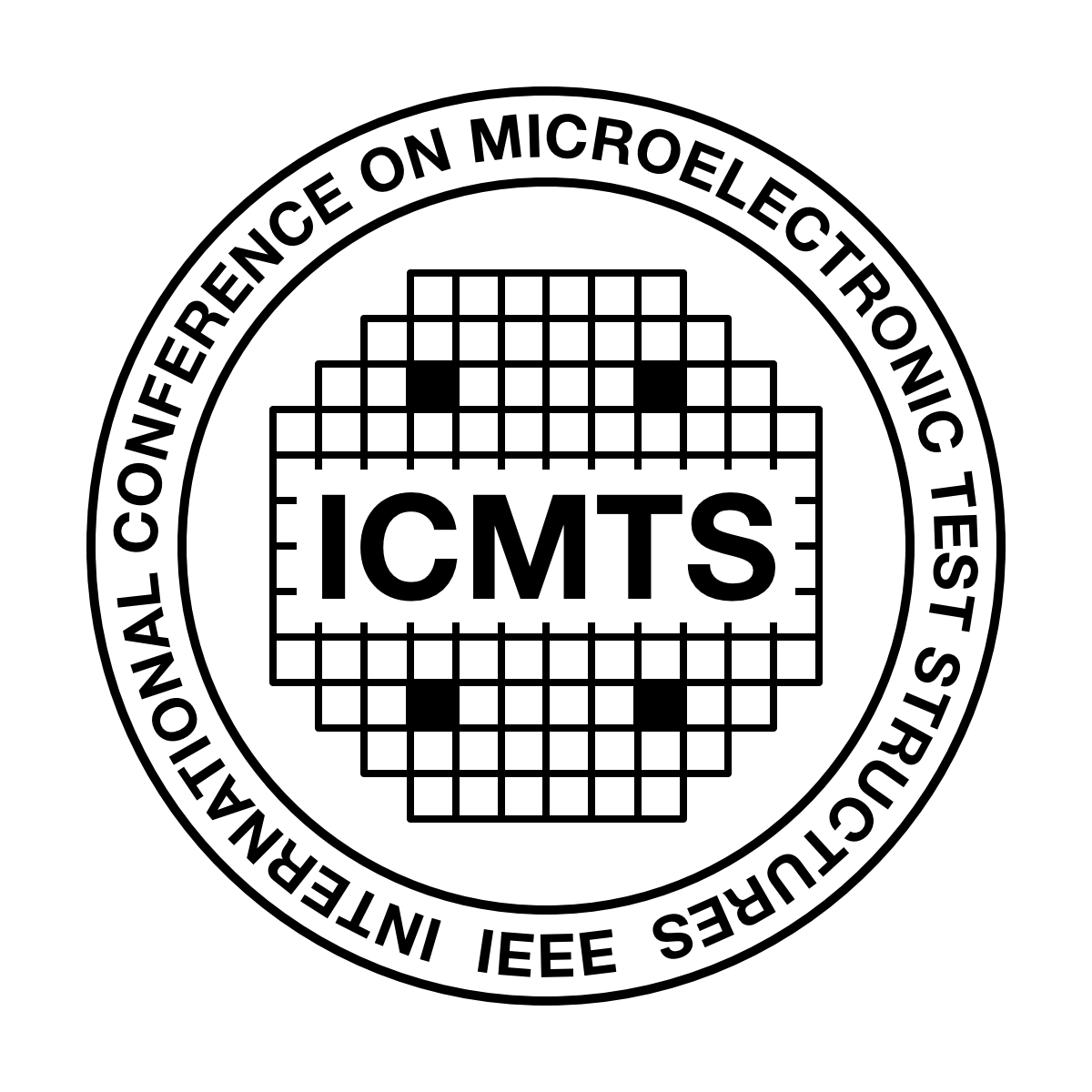IEEE International Conference on Microelectronic Test Structures
ICMTS 2026 Author Information
This page is intended for those who are interested in publishing their good work at ICMTS. First, you would write and submit an abstract. If your abstract is accepted, you will need to write a full manuscript, which IEEE calls an “extended abstract”. In addition, you’ll need to make and present a talk at the conference, Mar 23-26, 2026.
Each of those activities is discussed below.
- Abstracts (Submission Deadline: Nov 15, 2025) Example abstracts:


Abstracts are to have no more than four pages in PDF format (font-embedded):
- First page:
- Title
- Authors -- names, affiliations, contact email for the author to whom correspondence should be sent
- A short summary of the work, up to 50 words
- Second page: Text describing your good work
- Third (and maybe fourth) page: Figures, graphs, tables, ...

Please remember that the Technical Program Committee must read and evaluate dozens of these abstracts within a short timeframe. They greatly appreciate any abstract that gets its point across quickly and efficiently, staying within the four-page limit.
Abstract upload on this website will be enabled some time in early October. That link should be prominently displayed. You will be asked to enter the first author's name, the email for the author to whom correspondence should be sent, and asked to upload a PDF file with the abstract.
If you have any questions or issues, please contact the Technical Program Chair:
Tatsuya OHGURO, tatsuya.ooguro@toshiba.co.jp
Kejun XIA, kejun.xia@gmail.com - First page:
- Manuscripts (Final Manuscript Deadline: Feb 17, 2026)
This section is still under construction
Congratulations on your abstract being selected for ICMTS 2026!! This section provides the information you need to write and to submit your manuscript. This does not apply to invited talks or Tutorials, as manuscripts for them are not required.
First, each author must sign the electronic IEEE copyright form NEED A LINK. The deadline to do this is .
Your manuscript must be no longer than six pages long and uploaded to PDF eXpress by Feb 17, 2026. Failure to meet this deadline may result in the paper be labeled as 'withdrawn' from ICMTS 2026. All manuscripts will be collected from PDF eXpress to be included in the ICMTS Proceedings.
The Proceedings this year will be in A4 size. Any manuscript received in US Letter size will be scaled as needed.
IEEE provides lots of great resources for authors of technical papers like yours. Some useful links are provided below, plus you are encouraged to look through the other IEEE author resources yourself.
- IEEE Author Center for conferences
- IEEE MS Word and LaTeX manuscript templates for conferences
- IEEE eXpress conference publishing
- IEEE Style Manual
- IEEE Guide to References
Helpful hint: Use the "Cite This" button in IEEE Xplore® to get the text needed to reference a paper. This includes the reference's Document Identifier (DOI), a unique code for each publication. You can just copy/paste what "Cite This" provides into your manuscript.

If you have any questions or issues, please contact the Technical Program Chair:
Tatsuya OHGURO <tatsuya.ooguro@toshiba.co.jp>
Kejun XIA <kejun.xia@gmail.com> - Tutorials
Thanks you for agreeing to present a tutorial at ICMTS 2026!! This section provides the information you need to give your talk.
Tutorial Manuscripts
- No manuscript is required for tutorials, only your presentation slides.
Presentation Slides
- ICMTS does not require any specific slide template. Most presenters use their own organization's template.
- Your audience will be people who have paid extra to attend your tutorial, so they are interested in your topic.
- Each tutorial is a maximum of minutes long, to be followed by minutes of questions and answers. It is very important that you stay within your time limit in order to keep everything on schedule.
- All tutorial presentations will be printed into a book that will be distributed to all Tutorials attendees. Therefore, your audience will have your slides printed in front of them as you present.
- ICMTS will not electronically distribute your slides. Sometimes attendees will request an electronic copy of a presentation from a tutorial speaker. Providing an electronic copy of your slides is entirely your choice.
- Please email your final slides to the Tutorials Chair by no later than TBA. This provides the Chair enough time to print the books that are given to the attendees.
- It is not at all required, but if you want to use the ICMTS logo in your slides, a link is provided in the "Making Slides, Public Speaking" section below.
- We recommend that you watch the videos in the "Making Slides, Public Speaking" section below. They cover making your presentation slides and giving your talk in front of the audience and are applicable to all speakers.
Cost
- Tutorial speakers will be provided with a complementary registration to the full day of Tutorials.
- If you would like to attend the rest of the conference (which we highly recommend), that will be an additional cost.
- You are invited to attend the Monday reception along with all the other ICMTS attendees.
Speaker Biography
- Please provide the Tutorials Chair with a square photo of at least 200x200 pixels that can be used on the ICMTS website, guidance on how to pronounce your name, and a very short biography that can be read at the conference during your introduction.
- Whether or not you also include a biography slide in you presentation is entirely your choice.
If you have any questions or issues, please contact the Tutorials Chair:
Takayuki MORI <t_mori@neptune.kanazawa-it.ac.jp> - Technical Talks
Presentation Slides
- ICMTS does not require any specific slide template. Most presenters use their own organization's template.
- Each talk is a maximum of minutes long, to be followed by minutes of questions and answers. It is very important that you stay within your time limit in order to keep everything on schedule. It is highly encouraged to practice your talk until you are comfortable doing it within the time limit.
- Your audience should have access to the Proceedings so could have your paper in front of them as you present.
- A laptop will be used to project your slides, in either PowerPoint or Adobe PDF format. You should use very standard fonts in your presentation to avoid compatibility issues.
- ICMTS will not electronically distribute your slides, as IEEE regards that as re-publishing the same material that's in the Proceedings. Sometimes attendees will request a copy of a presentation from an author. It is then your choice whether or not to provide an elecronic copy of your slides.
- Please email your final slides to the Technical Program Chair by no later than TBA. Please use PowerPoint or Adobe PDF format.
- We recommend that you watch the videos in the "Making Slides, Public Speaking" section below. They cover making your presentation slides and giving your talk in front of the audience and are applicable to all speakers.
- Invited talks generally have a different time limit -- please contact the Technical Program Chair for details.
Cost
- At least one of the authors of each accepted abstract must register to attend the conference and present their work. Failure to do so could result in the paper being marked 'withdrawn' in the Proceedings and not loaded into IEEE eXplore®.
- You are invited to attend the Monday reception along with all the other ICMTS attendees.
Speaker Biography
- During the break that preceeds your talk, please contact the session chair. Tell him/her which of the authors will be presenting the paper, their affiliation (company, university, etc.), and provide guidance on how to pronounce their name.
- Sometimes, when a speaker is introduced, a very short biography will be read. If requested by the Technical Program Chair, please provide a very short biography of the speaker (one or two sentences, maximum, not your whole CV) to be read during their introduction.
If you have any questions or issues, please contact the Technical Program Chair:
Tatsuya OHGURO <tatsuya.ooguro@toshiba.co.jp>
Kejun XIA <kejun.xia@gmail.com> - Making Slides, Public Speaking
Giving a talk at ICMTS is similar to any other public speaking, except (a) you have a time limit and (b) if you're giving a technical talk, your slides should follow your paper. The videos below should help anyone giving a tutorial, an invited talk, or a technical talk.
Making Your ICMTS Presentation Slides (24min)
Giving Your ICMTS Presentation (10min)
 It is not necessary to include the ICMTS logo anywhere in your presentation but we've been asked multiple times to provide one, so here you are. Right-click on it and save it for your own use. It's shown small here but the file you save is 1200x1200 pixels.
It is not necessary to include the ICMTS logo anywhere in your presentation but we've been asked multiple times to provide one, so here you are. Right-click on it and save it for your own use. It's shown small here but the file you save is 1200x1200 pixels.








